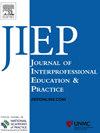Investigating Interprofessional Education (IPE) Faculty Development Programs within United States IPE Centers
Q3 Social Sciences
Journal of Interprofessional Education and Practice
Pub Date : 2025-07-22
DOI:10.1016/j.xjep.2025.100761
引用次数: 0
Abstract
Purpose
Interprofessional education (IPE) faculty development is vital for fostering IPE and collaborative practice initiatives. To our knowledge, there are no original research studies that describe the IPE faculty development in U.S. IPE Centers. The purpose of this study is to identify, describe, and expand the knowledge on IPE faculty development programs occurring within current IPE Centers in the U.S. through evidence-based research.
Methods
An electronic survey was distributed by email to 185 contacts for IPE Centers listed on the National Center for Interprofessional Practice and Education website. Descriptive statistics were performed on all closed-ended questions. The authors identified respondents’ open-ended comments and major thematic areas.
Results
Out of 169 deliverable emails, 70 responded to the survey and 57 met the inclusion criteria and completed the survey. Thirty-seven respondents (65 %) indicated that their institution/organization have a central IPE office and have dedicated staff/personnel. Thirty-eight respondents (67 %) reported that their institution/organization has an IPE faculty development program/activities. Almost all respondents (94 %) reported including training in the IPEC Core Competency areas. Length, format, and assessment results were varied.
Conclusions
This study provides valuable insights about IPE faculty development programs in the U.S. that may guide existing and developing IPE faculty development programs. The findings highlight the importance of institutional/organizational support, coordination mechanisms, and the need for standardized assessments in advancing the goals of IPE. Authors provide recommendations that may enhance the development, implementation, and sustainability of IPE faculty development.
调查跨专业教育(IPE)教师发展计划在美国IPE中心
目的跨专业教育(IPE)教师的发展对于促进IPE和合作实践的主动性至关重要。据我们所知,目前还没有关于美国国际政治经济学中心师资发展的原创研究。本研究的目的是通过基于证据的研究,识别、描述和扩展当前美国国际政治经济学中心的国际政治经济学教师发展项目的知识。方法通过电子邮件向国家跨专业实践与教育中心网站上列出的185个IPE中心的联系人发送电子调查。对所有封闭式问题进行描述性统计。作者确定了受访者的开放式评论和主要主题领域。结果在169封可发送邮件中,70封回复了调查,57封符合纳入标准并完成了调查。37名受访者(65%)表示,他们的机构/组织有一个中央IPE办公室,并有专门的员工/人员。38名受访者(67%)表示,他们所在的机构/组织有国际政治政治学院教师发展项目/活动。几乎所有的受访者(94%)都报告了IPEC核心能力领域的培训。长度、格式和评估结果各不相同。本研究为美国国际政治政治学院教师发展项目提供了有价值的见解,可以指导现有的和正在发展的国际政治政治学院教师发展项目。研究结果强调了机构/组织支持、协调机制的重要性,以及在推进国际政治经济学目标方面进行标准化评估的必要性。作者提供的建议,可能会加强发展,实施和可持续发展的国际政治政治学院师资队伍。
本文章由计算机程序翻译,如有差异,请以英文原文为准。
求助全文
约1分钟内获得全文
求助全文
来源期刊

Journal of Interprofessional Education and Practice
Social Sciences-Education
CiteScore
1.60
自引率
0.00%
发文量
80
期刊介绍:
Journal of Interprofessional Education & Practice, a quarterly online-only journal, provides innovative ideas for interprofessional educators and practitioners through peer-reviewed articles and reports. Each issue examines current issues and trends in interprofessional healthcare topics, offering progressive solutions to the challenges facing the profession. The Journal of Interprofessional Education & Practice (JIEP) is affiliated with University of Nebraska Medical Center and the official journal of National Academies of Practice (NAP) and supports its mission to serve the public and the health profession by advancing education, policy, practice & research.
 求助内容:
求助内容: 应助结果提醒方式:
应助结果提醒方式:


